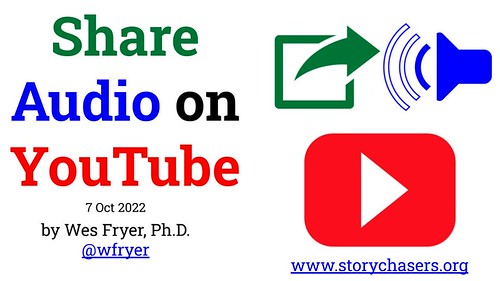Digital storytelling can take many forms. Recording an audio-only interview using a smartphone is one of the easiest ways to record a family oral history interview, but once you’ve recorded the interview, where do you share the file online? If you pay for a commercial web host to share your audio interview, you have to keep paying a monthly or annual fee to keep the linked file available for others on the World Wide Web to access. If you post to a “free” web service, that website (like Posterous, AudioBoo, and others) may go offline, get bought out, or delete all your content for another reason. How can we both SHARE and PRESERVE important audio digital stories, so they can remain online for years even after we’ve died and no one is paying a web hosting fee to share the files? The Audio Archive of the Internet Archive (archive.org) is one option, but YouTube is another. In this post, I’ll share how to use a free YouTube account and the free iOS app “Voice Record Pro” to share an audio-only file on YouTube.
As a middle school media literacy teacher, I love teaching my students how to conduct family oral history interviews. This 3 minute video highlights the steps for recording and using the iOS app, “Voice Record Pro” for an audio interview.
Whether you record your audio interview with the Voice Record Pro app or another app / website / software program, you can use Voice Record Pro to convert the audio file into a VIDEO FILE which includes a single image that is shown during the duration of the audio interview’s playback. The following is an example audio interview originally recorded and shared with the free Storycorps app. It’s an interview I recorded with my mother, Angie Fryer, back in 2016, when she talked about how she become a teacher and her early days of teaching in Abilene, Texas, and Mesquite, Texas. This video on YouTube is now a “cross-post” of the audio file hosted free by StoryCorps in their audio archive.
More examples of “Audio Stories” like this one, shared on YouTube, are available on this YouTube playlist from Storychasers.
This 11 minute tutorial highlights how to use Voice Record Pro to share an audio file on YouTube like those linked above.
More resources about creating and sharing oral history interviews and digital stories are available on the “audio interview” and “digital storytelling” pages of ShowWithMedia.com. Also check out www.storychasers.org for examples and resources for digital storytelling, especially using a smartphone or tablet computer.
If you enjoyed this post and found it useful, subscribe to Wes’ free newsletter. Check out Wes’ video tutorial library, “Playing with Media.” Information about more ways to learn with Dr. Wesley Fryer are available on wesfryer.com/after.






More Stories
Uvalde Border Patrol agent hailed as hero collects $17,000 in personal fundraiser
The Power Moves to Retain Teachers Amid the Pandemic
A Few of My Favorite Healthy Meals and Where to Buy Them